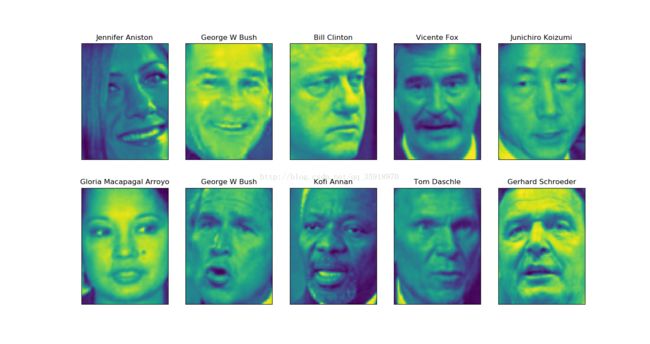sklearn 人脸识别
1.原始数据加载
import matplotlib.pyplot as plt
from sklearn.datasets import fetch_lfw_people
people=fetch_lfw_people(min_faces_per_person=20,resize=0.7)
image_shapes=people.images[0].shape
fig,axes=plt.subplots(2,5,figsize=(15,8),subplot_kw={'xticks':(),'yticks':()})
for target,image,ax in zip(people.target,people.images,axes.ravel()):
ax.imshow(image)
ax.set_title(people.target_names[target])
image_shape输出图像类型为87*65像素
原始数据集为字典类型,可通过点语法访问其键值,如target,image,target_names
axes.ravel()可访问所有子图

In [20]: people.images.shape
Out[20]: (2341, 87, 65)
In [21]: len(people.target_names)
Out[21]: 39
图片大小87*65
属于39个人
每张图片都有target属性作为标记
2.预处理
为了使数据减少倾斜性,每个人只取小于等于50张照片,也是为了减少某个人童年时期照片太多而造成的过拟合
import numpy as np
mask=np.zeros(people.target.shape,dtype=np.bool)
for target in np.unique(people.target):
mask[np.where(people.target==target)[0][:50]]=1
X_people=people.data[mask]
y_people=people.target[mask]
#scale the grayscale value to be between0 and 1
#instead of 0 and 255 for better numric stability
X_people=X_people/255
X_people
In [32]: X_people
Out[32]:
array([[ 0.24313726, 0.2379085 , 0.20261438, ..., 0.70065361,
0.66013068, 0.64313728],
[ 0.31633985, 0.32287583, 0.39084965, ..., 0.20522875,
0.20522875, 0.21045752],
[ 0.78954244, 0.78562087, 0.77908498, ..., 0.05359477,
0.05359477, 0.05228758],
...,
[ 0.15163399, 0.15294118, 0.15294118, ..., 0.19346404,
0.16862746, 0.16732027],
[ 0.36732024, 0.4130719 , 0.44705883, ..., 0.94901961,
0.95816994, 0.96732026],
[ 0.07843138, 0.08496732, 0.11633987, ..., 0.51764709,
0.53202617, 0.53464049]], dtype=float32)In [34]: y_people
Out[34]: array([19, 10, 6, ..., 0, 3, 12])
fetch_lfw_people库需要从官网下载
image_shape输出图像类型为87*65像素
原始数据集为字典类型,可通过点语法访问其键值,如target,image,target_names
axes.ravel()可访问所有子图fetch_lfw_people库需要从官网下载
image_shape输出图像类型为87*65像素
原始数据集为字典类型,可通过点语法访问其键值,如target,image,target_names
axes.ravel()可访问所有子图